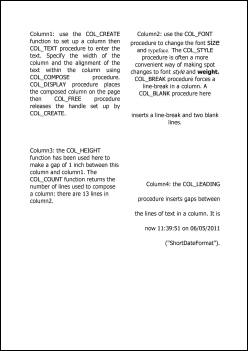// REDTITAN RS2 CONTROL
PAGENUMBER:= strtointdef(paramstr(1),0);
if PAGENUMBER>10 then halt(1);
CX1:= col_create; //COLUMN1
col_font(CX1,14,'Tahoma');
WORDS1:= 'Column1: use the COL_CREATE function to set up a column then COL_TEXT procedure to enter the text. Specify the width of the column and the alignment of the text within the column using COL_COMPOSE procedure. COL_DISPLAY procedure places the composed column on the page then COL_FREE procedure releases the handle set up by COL_CREATE.';
col_text(CX1,WORDS1);
col_compose(CX1,1800,'fill');
col_display(CX1,600,600);
H1:= col_height(CX1);
col_free(CX1);
CX2:= col_create; //COLUMN2
col_font(CX2,14,'Tahoma'); col_text(CX2,'Column2: use the COL_FONT procedure to change the font ');
col_font(CX2,18,'Tahoma'); col_text(CX2,'size ');
col_font(CX2,14,'Tahoma'); col_text(CX2,'and ');
col_font(CX2,14,'Times New Roman'); col_text(CX2,'typeface. ');
col_font(CX2,14,'Tahoma'); col_text(CX2,'The COL_STYLE procedure is often a more convenient way of making spot changes to font ');
col_style(CX2,'italic'); col_text(CX2,'style ');
col_font(CX2,14,'Tahoma'); col_text(CX2,'and ');
col_style(CX2,'bold'); col_text(CX2,'weight.');
col_font(CX2,14,'Tahoma');
col_break(CX2);
col_text(CX2,'COL_BREAK procedure forces a line-break in a column. A COL_BLANK procedure here');
col_blank(CX2,2);
col_text(CX2,'inserts a line-break and two blank lines.');
col_compose(CX2,1800,'cj');
col_display(CX2,2600,600);
LINES2:= inttostr(col_count(CX2));
col_free(CX2);
CX3:= col_create; //COLUMN3
col_font(CX3,14,'Tahoma');
WORDS3:= 'Column3: the COL_HEIGHT function has been used here to make a gap of 1 inch between this column and column1. The COL_COUNT function returns the number of lines used to compose a column: there are '+LINES2+' lines in column2.';
col_text(CX3,WORDS3);
col_compose(CX3,1800,'lj');
col_display(CX3,600,1200+H1);
col_free(CX3);
CX4:= col_create; //COLUMN4
col_font(CX4,14,'Tahoma');
WORDS4:= 'Column4: the COL_LEADING procedure inserts gaps between the lines of text in a column. It is now '+now ('hh:nn:ss')+' on '+ now('ddddd')+' ("ShortDateFormat").';
col_text(CX4,WORDS4);
col_compose(CX4,1800,'rj');
col_leading(CX4,150);
col_display(CX4,2600,3600);
col_free(CX4);
if PAGENUMBER=9 then halt(1);
|

